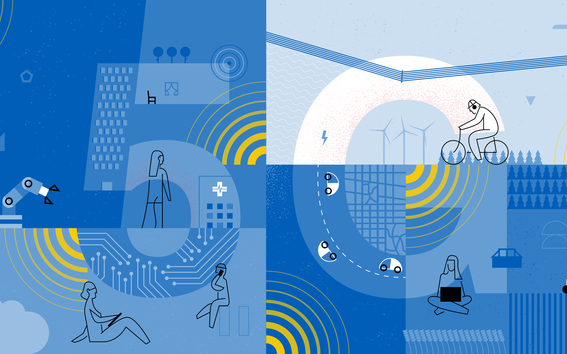Figuring out our 5G future

Whenever a new generation of wireless-network technology arrives, we typically start hearing about its rollout long before it becomes part of our everyday lives.
The first 3G network was launched in 1998, but the main services that 3G enabled – mobile email and video streaming – only took off properly in the early 2000s (it would be 2005 before YouTube entered our lives). The world’s first 4G network was launched at the end of 2009, bringing us speeds 500 times faster than 3G and supporting the services we grew up with in the 2010s: group video chats, online gaming, and browsing as if on a desktop.
Now we’re into the era of 5G, with a stop-start rollout pattern that mirrors the development of its predecessors. But whereas previous network generations enabled step changes in consumer services, the introduction of 5G is more of a giant leap forward for the way in which industry uses network technology. With its capacity to handle massive amounts of data at low latency (i.e. with very little delay) and offering the ability for networks to be split into slices, 5G promises to transform wireless communications across many sectors.
'One of the things that makes 5G different is that the network software runs in the cloud, instead of on a physical server. This makes scaling 5G up and down for different functions much easier and more flexible than was possible with previous wireless generations,' says Raimo Kantola, Professor of Networking Technology at Aalto University.
'The rollout of a new generation always takes several years, as base stations need to be installed at tower sites and then properly integrated with the network,' he says.
'In some parts of Europe, spectrum licenses for 5G have not even been awarded yet. But in Finland things are moving ahead well, with the mobile operators recently announcing that their 5G coverage now reaches 30 to 40 percent of the population. The rollout is progressing quickly in the United States and China too,' says Kantola.
One network, many slices
Aalto University contributes to the field with research into the industrial use cases that 5G enables.
Using equipment donated by Nokia, a team from the Department of Communications and Networking has been running a small 5G network on the university’s campus since early 2019. The team is led by Staff Scientist Jose Costa-Requena, who also serves as CEO of network-technology developer Cumucore.
'All the earlier generational shifts in this industry were about bringing more, better and faster services to consumers. But 5G is mainly for industrial usage and establishing private networks,' says Costa-Requena.
'In addition to its high bandwidth and low latency, one of the key features of 5G is its capacity for the network to be split into what we call slices,” he says. 'Each slice is essentially a network in its own right, with a security and data-handling profile that may be completely different to the next slice. This allows mobile operators to build multiple specialized private networks for their customers.'

Enhancing network security
The security features of earlier network generations were mainly designed around encrypting data traffic. With 5G, security is a lot more robust.
'Every time a 5G base station and the network core connect, they need to authenticate each other. This requirement did not exist in previous generations,” says Costa-Requena. “There is also additional security at the application layer, on the device in your hand.'
'The challenge though is that this level of security is extremely difficult to deploy at scale,' he says. 'To make a really secure 5G system, you need to combine the security features of three constantly moving pieces: the base station, the core and the device itself.'
Costa-Requena and his team are tackling the base station challenge first. This means working with manufacturers like Nokia to test both primary and secondary authentication profiles in their products.
Using drones to collect data
The team has also been studying drone technology.
Drones are increasingly used for commercial purposes, and 5G networks will open up even more options. Some of the Aalto researchers have been testing how drones can help firefighters.
'The idea is that 5G will enable fire departments to deploy a robust private network from one of their trucks when out in a remote area. They can then use this network to control drones that collect and broadcast video footage to all the teams fighting the fire,' says Costa-Requena. 'We’ve been testing this scenario with Korean partners in an EU-Korea cooperation project.'
The initiative grew out of an earlier study by Aalto University and Yonsei University in Seoul. Instead of drones, the team used specially-equipped balloons to spot and report car accidents to emergency crews over South Korea’s 5G network.
Jose Costa-Requena, staff scientist at Aalto University and CEO of CumucoreIf we can bring the low latency of 5G into the energy industry, there’s a strong case for replacing fibre with wireless technology
Connecting smart grids
The team’s work on energy grids is focused on studying the potential impact of moving from fibre-optic cables to 5G.
In traditional energy grids, the flow of electricity is one-way: from central electricity generators to customers. But the next generation of energy grids – or smart grids – introduces two-way transmission of electricity and information, creating a distributed energy-delivery network. With such a model, failures need to be detected in real-time and recovered automatically. This means deploying lots of sensors, and introducing more IT support than is necessary today.
The challenge with all this is cost. Energy grids often use expensive fibre-optic technology for the final metres into a building, then connect back to the wireless network core via an existing cellular standard. 5G has the potential to complement and replace these fibre-optic cables so that grids can be managed at a lower cost.
'Fibre is very reliable, but it’s also extremely expensive,' says Costa-Requena. 'If we can bring the low latency of 5G into the energy industry too, then there’s a strong case to be made for replacing fibre with wireless technology.'
Despite the many advantages of the smart grid, the increased interconnectivity between its different components makes such networks especially vulnerable to cybersecurity attacks.
'The attacks aim to interrupt the functionality of critical services and can cause remarkable damage, including power outages,' says Ph.D. candidate Mandana Ghasemi, who specializes in network security and trust. 'We are doing a lot of work on developing tools to enhance the security of smart grids so they can run securely over 5G.'
Controlling autonomous vehicles
The team is also testing 5G in controlling self-driving cars.
Using two of the base stations on Aalto University’s campus, the researchers have established a network that allows for short test drives in a car developed by Finnish start-up Sensible 4. The company specializes in self-driving vehicles that can handle any weather conditions.
'Sensible 4 is currently using 4G technology to control their vehicles. This means having two modems, in case one loses coverage or breaks down,' says Costa-Requena. 'Our experiment is about testing the latency and reliability of 5G in the autonomous driving scenario, with a view towards introducing this capability when the time is right.'
Text: Andrew Flowers







